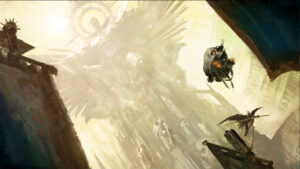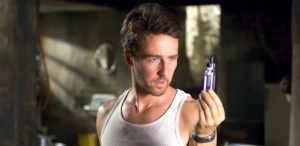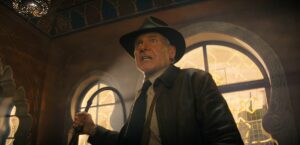Wrestlers are known for their physical prowess, larger-than-life personalities, and ability to captivate audiences. Over the years, many professional wrestlers have parlayed their success in the ring into successful acting careers. It makes sense on a certain level. Performing is still performing, whether it’s on a stage, in a ring, or on a giant screen.
From Dwayne “The Rock” Johnson to John Cena to Dave Bautista, these wrestlers-turned-actors have taken over Hollywood by becoming some of the biggest movie stars in the world, or character actors sinking into roles. Action is what their talents are most obvious for, but as you’ll see below, many wrestlers have taken their considerable talents and transferred them into all kinds of roles.
From lovable giants to cynical heroes who see through the bullshit to heartbroken true believers, these are some of the best performances from wrestlers-turned-actors.
Knock at the Cabin

Kicking us off is M. Night Shyamalan’s Knock at the Cabin, which continued his miracle “comeback” run as of late. Perhaps most exciting about his apocalyptic potboiler is the hulking Dave Bautista at the center. Bautista, a former WWE world champion and future Hall of Famer if rumors are to be believed, has been acting for about a decade now. In that time, he’s done everything from comedy to children’s movies to being a part of the Marvel Cinematic Universe.
It’s that latter role, Guardians of the Galaxy’s Drax the Destroyer, that’s given Bautista his most success, allowing him to flex his comedic muscles and the space to explore introspection in brief, quiet moments. His light touch, despite being a giant of a man, took audiences totally off guard in Blade Runner 2049. In just five short minutes (and a pair of tiny glasses), Bautista immediately stole the film from his more established co-stars, giving a haunting performance that lives in your mind long after he’s killed off.
It’s this delicate nature and those tiny glasses that Bautista brings to Knock at the Cabin in the film’s central role. As Leonard, the leader of a group of people having apocalyptic visions, he besieges a remote cabin, forcing the couple and their child inside to choose someone from their family to sacrifice in the name of saving the world. In Leonard’s introduction, Shyamalan makes brilliant use of Bautista’s size. Framing him in extreme close-ups, only a hand or arm visible, he greets little Wen (the couple’s child) and introduces himself as a potential friend. The implication here, before we know anything about him or his plans, is already scary. A man approaching a child and asking to be their friend is frightening in any context, but somehow, Bautista’s demeanor cuts through that into something almost soothing. Your mind tells you this isn’t OK; Shyamalan’s refusal to show him in full like he’s the shark from Jaws only exacerbates that, but his calming presence is enrapturing.
Bautista is the trick to the entire film. Without him, this is a group of lunatics asking a family to do the unthinkable — to sacrifice one of their own on behalf of the visions of strangers. Their rantings and ravings are ludicrous, but Bautista centers that. There’s a flutter of pain every time he speaks, a sadness that breaks your heart. You might not believe his warnings, but you believe that he believes. It’s a remarkable bit of line-toeing, so to speak, maybe even making the events scarier because of the perverse sense of calm he brings. Covered in tattoos, with a shaved head, and towering as if he’s the size of a house, this quiet and charismatic behemoth’s persistence of belief washes over you, making you second-guess yourself. Few people have been this suited to Shyamalan’s earnest, occasionally goofy dialogue. Bautista accesses an almost childlike state of being, one that fully accepts things as they are and finds wonder in their beauty. It’s something he brought to Drax that pushed him beyond comic relief. Turning that on its head as Leonard is frightening. He sees our world and the people in it and all of that messy beauty. All he wants to do is save that by any means necessary. And it breaks his heart.
Knock at the Cabin is streaming on Peacock, and available for digital rental or purchase on Amazon, Apple TV, Google Play, and Vudu.
Pain & Gain
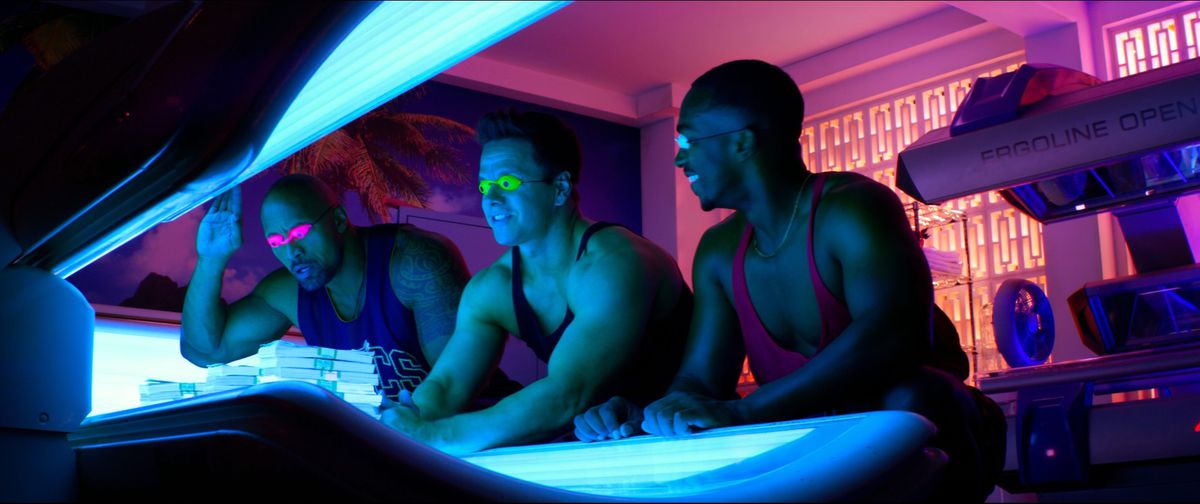
It’s a bit tough to like Dwayne Johnson these days. The one-time face of WWE alongside Stone Cold Steve Austin during the halcyon “Attitude Era” days has seemingly fully bought into his megastar status. Whether it’s essentially playing an AI-generated version of himself in anonymous blockbuster after anonymous blockbuster or having a bizarre meltdown over Black Adam’s lack of success, it could be easy to forget Johnson was once an electrifying new movie star.
After his initial run of starring vehicles, Johnson briefly allowed himself to be used in interesting ways by filmmakers with legitimate points of view. There’s the oddly prescient mega-bomb Southland Tales and his excellent, twitchy performance within, of course, but it’s hard to argue that Johnson has ever been better than in Michael Bay’s acidic look at the American dream, Pain & Gain. Based on a true story, Pain & Gain follows three gym meatheads (Mark Wahlberg, Anthony Mackie, and Johnson) as they descend into violent idiocy in an attempt to get rich quick. After multiple attempts to extort a rich businessman (Tony Shalhoub), the trio’s schemes become more psychotic (and hilarious) while the police are unwilling to believe three morons could pull something like this off.
A brief comedown for Bay during his Transformers period, the film is refreshingly small, allowing room for some truly ridiculous characters to shine through. None are bigger (literally) or funnier than Johnson’s Paul Doyle. Recently out of prison, Doyle is a born-again Christian who claims to have an aversion to violence. As their plot quickly gets out of hand, Doyle’s convictions repeatedly fail and Johnson is hysterical as a musclebound goliath fighting back tears as he lays waste to people. Similar to Bautista’s best work, Johnson locates a childlike innocence in Doyle. But where Bautista’s is laced with wonder and awe, Johnson’s Doyle is a psychopathic idiot. Both believing that God has granted him the power to “knock people the fuck out” and that what they’re doing isn’t all that wrong, Johnson is the key to Bay’s ethos within the film.
Bay is often deeply distrusting of institutions, and is willing to give individuals the time of day over the systems in which they work. He’s been tagged as a military propagandist, but when you view his work as whole, it becomes apparent his reverence is for the people who do these jobs and less in the juggernaut that houses them. That frame of mind is no different in Pain & Gain, as Bay isn’t simply making fun of these men — he finds an empathy for them. These are guys who couldn’t cut it anywhere else in life. In a dead-end capitalistic society, desperation often wins the day, and you make decisions you otherwise wouldn’t. Prison isn’t designed to rehabilitate people, so when Johnson’s Doyle is put back out on the street, he’s a broken man looking to religion and magic power for answers. Of course he’d be easily taken in by Wahlberg’s equally stupid but much more confident conman. Bay understands that as this country leaves people behind, one needs to empathize a bit with drastic measures. Because isn’t everyone entitled to the American dream? That’s the promise of this country, and it’s one these men have bought into without fail.
Yes, Pain & Gain is wildly funny, and it’s easy to see these men as a joke, but Bay and Johnson ride that line just well enough that through the laughter you also kind of feel bad for them. Doyle might be deranged, but that doesn’t make him a “bad” person. He’s just somebody who’s lost in the sauce of wanting more for himself. Johnson’s simultaneously giddy and frightened performance drives that home.
Pain & Gain is streaming on Paramount Plus, and available for digital rental or purchase on Amazon, Apple TV, Google Play, and Vudu.
They Live
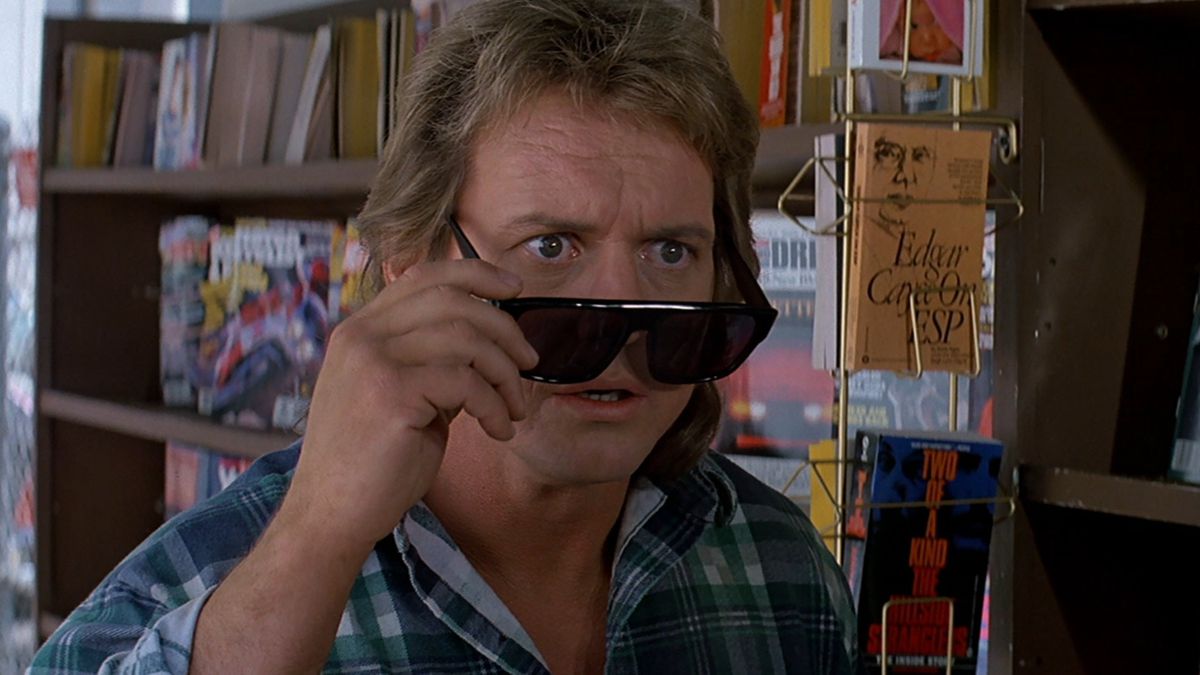
Keeping with the furious (and funny) looks at America, let’s jump back to the ’80s with John Carpenter’s classic They Live. Despite the iconography, its black-and-white reality of alien figures telling you to “conform” and “consume” being more prescient with each passing year, it’s also just a great film. We all know this one — aliens have discreetly taken over our world and are living among us. They’re behind every advertisement, billboard, movie, and TV show, and the only way for people to see through them is to put on a special set of sunglasses.
Roddy Piper’s Nada is one of those people, and in putting on the glasses, he’s sent down a path that just might save the world. Piper was an interesting choice for an action hero. Never the biggest guy on any wrestling roster but always the loudest, he spent the majority of his career playing a heel (wrestling parlance for “bad guy”). In the ’80s “Rock ’n’ Wrestling” boom period, no villain taxed megastar Hulk Hogan like Rowdy Roddy Piper. His sardonic wit and fast-on-his-feet improv-like ability to turn wrestling promos on their head was a sight to behold.
It’s easy to see why Carpenter went with him. Piper fits right into this cynical, distrusting world, and you can feel his eyebrows raising well before he ever puts on the glasses. It’s sometimes hard to parse what Carpenter was trying to say with this film when he speaks about it himself — like Nada, the filmmaker is a very funny but cynical guy, and doesn’t seem to have much use for picking thematic details out of his work. There’s potent disgust for anything or anyone tied to wealth in They Live, and it’s no mistake that our lead and his ragtag group are unhoused. There shouldn’t be any doubt to whom Carpenter’s hatred is directed, and it makes any misunderstanding of this one as some sort of Illuminati/lizard people parallel deeply silly.
Full of classic one-liners (“I’m here to kick some ass and chew bubblegum, and I’m all out of bubblegum”) and iconic imagery, nothing from They Live has aged as beautifully as the prolonged fight between Piper and Keith David. Grueling, exhausting fights are all over Western cinema now (see: the recent John Wick: Chapter 4), but at the time, this was something of a novelty. Just when you think these two hosses are done, they keep going, another thudding blow landing square in somebody’s mug. This is what makes Piper most ideal for Nada. He comes from a world where choreographed fights are inherent to telling a story. In those stories, Piper was usually the villain. Here, he gets to play out the arc of a hero, but instead of raising a world championship belt (something Piper sadly never got to do), his victory is finally putting those glasses on Keith David and helping him see the light. Four decades later, few fights are as fulfilling.
They Live is available for digital rental or purchase on Amazon, Apple TV, Google Play, and Vudu.
Ed Wood
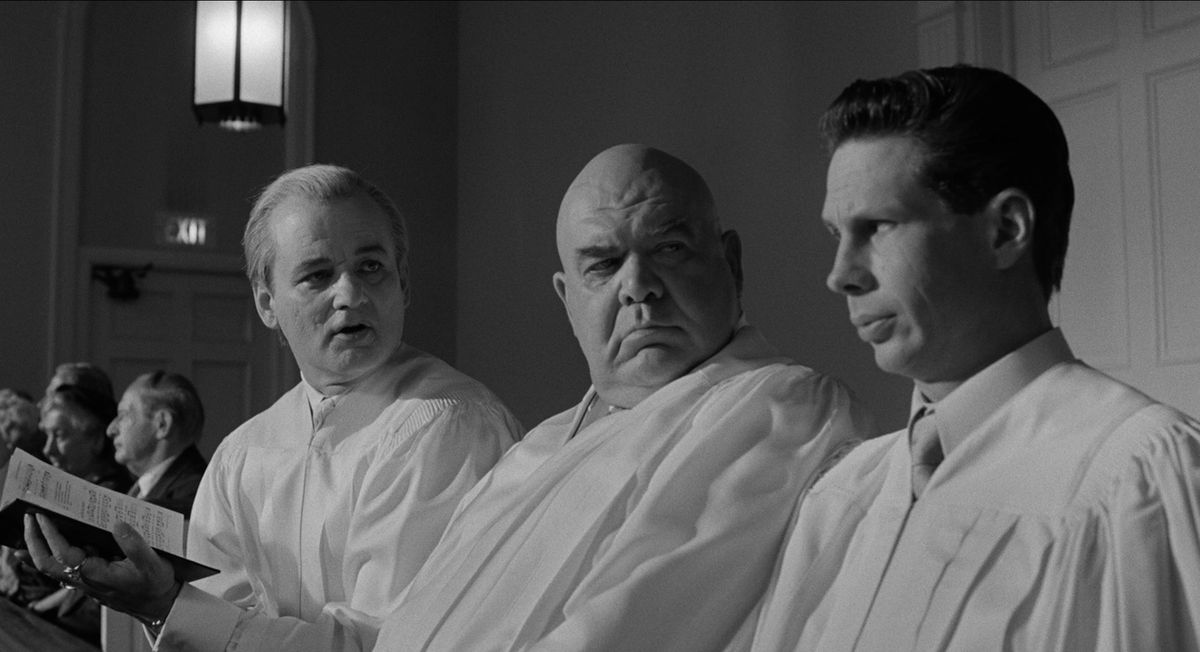
Tim Burton’s Ed Wood is a bit of a curveball for a piece like this but it does, in fact, co-star a wrestler. Mixed within those who make up Ed Wood’s cavalcade of weirdos is real-life wrestler Tor Johnson, played by legendary oddball wrestler George “The Animal” Steele.
The 1994 biopic tells the story of the most famous “bad” director of all time, Ed Wood, and his quest to make his magnum opus, Plan 9 From Outer Space. Shot in black and white and taking many liberties with the true-life story, it’s a tale of persistence in the face of doors being slammed on you, all while staying true to a singular vision that you can’t help but show to the world. Ed Wood’s outsider passion is akin to Burton’s, and even though the former never reached the highs of the latter, you can see why Burton wanted to tell his story.
The early days of film had a carny-like feel to them, and often featured a ton of “freaks” and fringe characters making up the bulk of the workers. There’s a direct throughline between cinema and wrestling in this regard, with carnies being the lifeblood and backbone of the early days of both. Wood surrounds himself with all kinds of margin dwellers, most notably a fallen-from-grace Bela Lugosi, but one standout was Swedish wrestler Tor Johnson.
Johnson, who like many on this list made the transition to acting himself, was a hulking bald brute who often played monsters. That’s exactly what he did in Wood’s film, playing an undead police inspector resurrected by the invading aliens to be their muscle. George Steele was perfect casting as the towering Johnson, not just in appearance but in demeanor, too. By all accounts, Johnson was a sweetheart behind the scenes, and Steele’s performance is a perfect dichotomy of terrifying and wholesome. It wasn’t a far cry from Steele’s own wrestling persona. Starting as a well-spoken heel for heroic champions to dispatch before shifting into a monstrous wildman, Steele’s biggest crossover success came in that ’80s boom period led by Hogan and Piper. As that wildman, Steele would tear the turnbuckles from the ring posts and eat the foam inside, grunting monosyllabically. Behind the scenes, Steele was a soft-spoken and intelligent guy who could turn into his character in an instant. To thousands of fans across the world he was a gigantic brute who would terrorize Macho Man Randy Savage and shout “Duh-dah!!” but to people who knew him, he was a giant teddy bear. Outside of Martin Landau’s terrific transformation into Lugosi, Steele might just be the best casting choice in the film. He’s the embodiment of that carny lifeblood pulsing through the two industries: an oddball on the surface who society would cruelly brush off, but someone with an internal life, passion, and love underneath.
Ed Wood is available for digital rental or purchase on Amazon, Apple TV, Google Play, and Vudu.
Rocky III
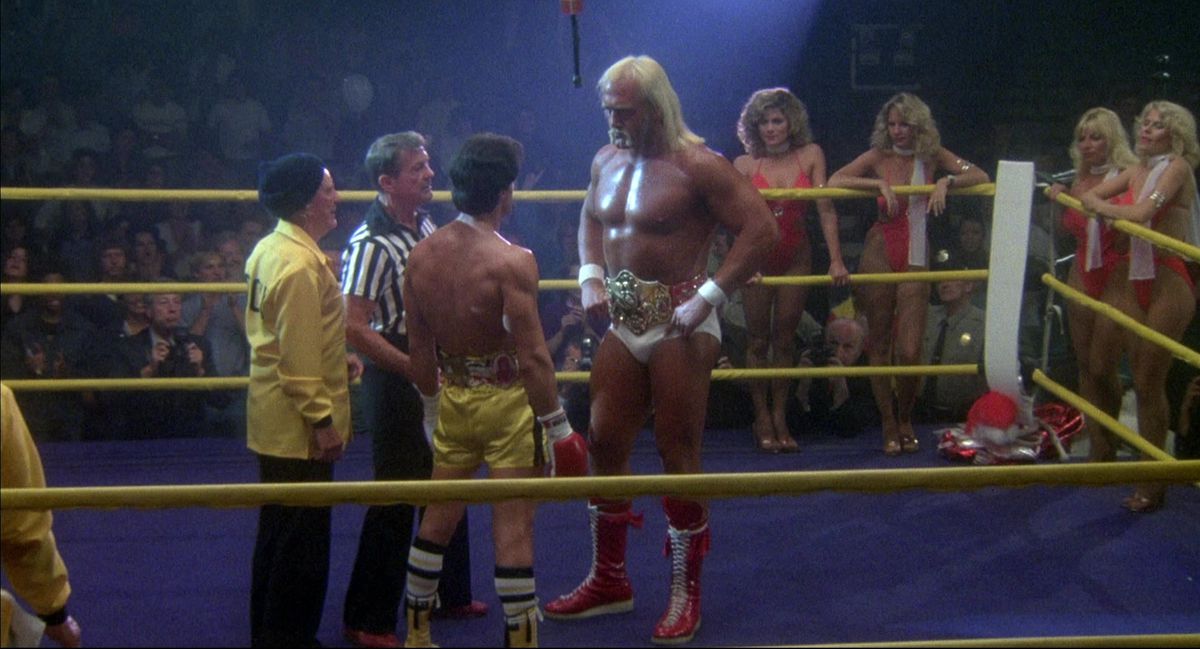
For better or worse, this wouldn’t be a list of wrestlers in film without the industry’s first major crossover success, Hulk Hogan. Hogan, the man who carried wrestling from a territorial interest in the ’70s to a worldwide phenomenon in the ’80s, was never a great actor. Where guys like The Rock, John Cena, and Dave Bautista have found various degrees of success in the ability to transform into different characters, Hogan never felt like he wasn’t reading lines. Every interaction in every film is stilted, Hogan staring through his scene partner waiting to say the corresponding bit of dialogue. Hulk Hogan never had the ability to not be Hulk Hogan.
That’s why his best performance is his first, Thunderlips in Rocky III. Rocky III was a nexus point in the series. Where the first two felt like kitchen sink dramas about a down-on-his-luck boxer fighting from beneath just to be somebody, the third installment sees that underdog on top of the world. It mirrors its creator Sylvester Stallone’s trajectory, as he also fought from beneath as a bit player in the New York film scene who had nothing but a script and a dream. By 1982, he was a superstar, and his films were transitioning from those down-to-earth dramas to muscular, high-octane action. Rocky III is the pivot point because our villain goes from the larger-than-life (but nonetheless based in reality) Apollo Creed to the wildy cartoonish Clubber Lang played by Mr. T.
In a standout scene, Rocky’s excesses are put on full display in a wacky charity event where he squares off with wrestling superstar Thunderlips. As Thunderlips, Hulk Hogan essentially gets to play himself. While he wasn’t quite the megastar or world champion that would send wrestling into the stratosphere just yet, his performance showcases everything people would come to love and ultimately embrace about “Hulkamania.” A loud, musclebound Saturday Morning cartoon, Hogan’s Thunderlips toys with Rocky to the delight of the crowd, throwing him all over the ring. Hogan as Thunderlips is the perfect encapsulation of where cinema was heading over the next decade. Action would embrace these cartoon-like, one-liner-spewing behemoths as their heroes, and while Hogan would attempt to cash in on that with his own failed vehicles, he was never better than when he played himself.
Rocky III is streaming on Netflix, Prime Video, Paramount Plus, and MGM Plus. It is also available for free with ads on Tubi and Pluto TV, or for digital rental or purchase on Amazon, Apple TV, Google Play, and Vudu.
The Princess Bride
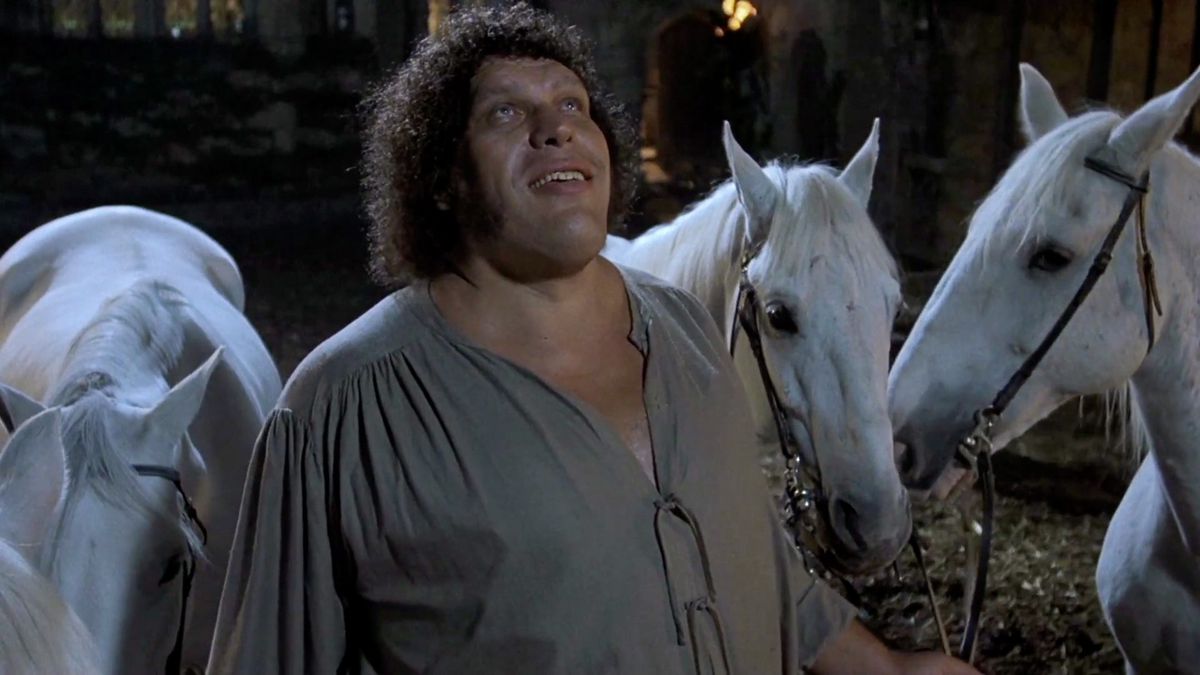
You can’t talk about the rise of Hulk Hogan without mentioning his greatest foil, André the Giant. Simply put, without André, there might not be a Hulk Hogan. Hogan rode his success into WWE’s flagship event, Wrestlemania, and teamed with Mr. T in a fun tag-team main event. A year later at WrestleMania 2, Hogan still had steam, but there was a noted lack of electricity in his main event outing against King Kong Bundy. It would take a bigger-than-life attraction to pit against Hogan and help him get his mojo back.
Enter: André the Giant.
The build to WrestleMania 3 was centered around “can Hulk Hogan slam André?” and when he finally did it, the roof practically exploded from 90,000 screaming fans. There is no more indelible image in wrestling history than Hogan slamming André.
André the Giant was the ultimate unbeatable villain. At a towering 7-foot-4 and over 500 pounds, André was the perfect final boss for any conquering hero. Slamming him was achieving the impossible. In real life, the French behemoth couldn’t have been more different. Like many of the wrestlers on this list, he was a kindhearted giant in his day-to-day life and beloved by anyone who knew him. That made him a perfect addition to Rob Reiner’s fairy tale, The Princess Bride.
As the lovable henchman Fezzik, André brought a delightful balance to the trio of bandits supporting our leads. While Wallace Shawn’s Vizzini was conniving and sneaky and Mandy Patinkin’s Inigo was honorable yet driven by vengeance, Fezzik was an innocent jokester, happy to be along for the ride. André ultimately plays a comedic side character, but his screen presence is so lovely, again accessing that childlike state of being like many on this list. There’s a twinkle in his eye every time he’s on screen that lies somewhere between awestruck and mischievous. Like his real-life wrestling counterpart, his turn to the side of the angels (something André ultimately got to do before his in-ring retirement) is so rewarding because of how lovely that smile and laugh are. He wasn’t giving a world-class performance, but he didn’t have to. His gleeful personality is what sticks with you and makes you remember him. A giant stands out in any crowd, regardless of how colorful a cast of characters they are. That’s true in wrestling and film. A giant with a soul like André’s lives forever.
The Princess Bride is streaming on Disney Plus, available for digital rental or purchase on Amazon, and available for digital purchase on Apple TV, Google Play, and Vudu.
Fighting With My Family

This one doesn’t exactly star a WWE wrestler, but it features many and is about one. Far and away the most successful film in WWE Studios’ library, Fighting With My Family was a critical and commercial triumph. Starring Florence Pugh as WWE wrestler Paige, it charts the popular star’s rise to fame within the company. In real life, Paige likes to joke she’s been wrestling since she was in the womb, as her mother (British independent wrestler Sweet Saraya, portrayed in the movie by Game of Thrones’ Lena Headey) unknowingly wrestled matches while pregnant.
Paige’s story — first as a girl coming of age in a ring surrounded by a family of wrestlers, then as a woman who didn’t have the look WWE desired but still found success — is compelling. So compelling, in fact, that a documentary short was made (also called Fighting With My Family) following Paige’s and her brother Zak’s attempts to be signed by WWE. As the story goes, The Rock, having seen the documentary, was so enamored with Paige’s journey that his production company (Seven Bucks Productions) bought the rights and partnered with WWE to recreate the inspiring journey.
While ticking the well-worn boxes of any sports biopic, the film manages to rise above to be a delightful slice of the kind of life we rarely see on screen. Sure, we’ve seen the social outcast proving everyone wrong on their way to victory, but the scrappy world of British independent wrestling is a unique setting for this kind of narrative.
Stephen Merchant’s lovely script cuts through the schmaltz, but the lion’s share of credit has to go to Florence Pugh. Released the same year as Midsommar and Little Women, it’s easy to forget this one hit first. Already seen as a rising star thanks to Lady Macbeth, Pugh exploded in 2019, giving three wholly distinct and well-realized performances. If you haven’t seen Fighting With My Family, Pugh sinks right into her role as Paige, nailing her sardonic wit and suffer-no-fools attitude. It’s a good film, but Pugh is great, radiating the kind of magnetism so few possess. The idea that you’re watching a major star in the making is as clear as day.
As a fun time capsule of one our biggest movie stars right as she broke big, Fighting With My Family is essential. That it’s a rock-solid sports/family drama packed with earned emotion is a bonus. Just try to ignore Dwayne Johnson gracelessly inserting himself into the film for a few moments that absolutely didn’t happen in real life.
Fighting With My Family is available for digital rental or purchase on Amazon, Apple TV, Google Play, and Vudu.
The Marine 3-6
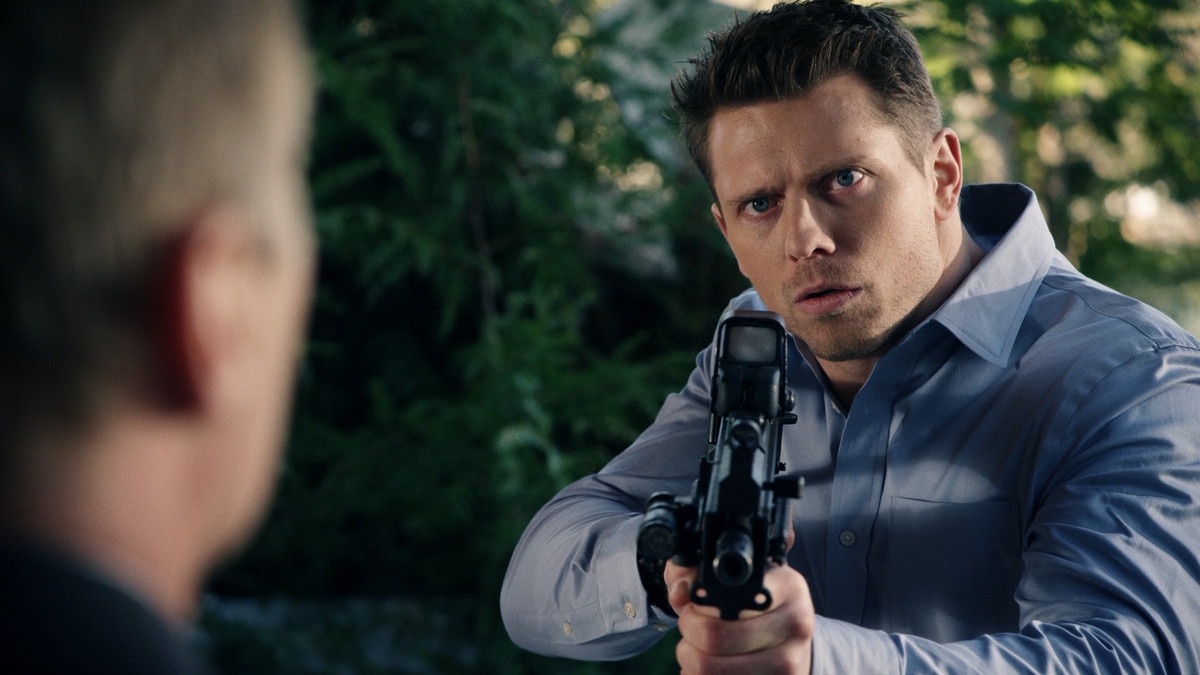
Even if you have zero knowledge of WWE Studios, you’ve likely heard of The Marine. Starring John Cena, it was one of WWE’s first solo outings as a production company and, to be frank, it’s not great. If you’re at all familiar with the DTV action market, you know no minor action film is truly dead, because all you need is name recognition and a vaguely well-known face to keep the flame alive for endless installments. That forced franchising was The Marine’s fate isn’t exactly surprising. What is surprising is how the franchise not only got better, but got flat-out great as it went along.
DTV action is filled with these kinds of success stories (the Universal Soldier and Undisputed series being among the best examples), but those were built on steady ground. If you were one of the few sitting in a theater enduring the first Marine movie, there’s no way you’d ever believe that by the sixth entry you’d be on the edge of your seat, holding back tears as it came to a close. That at the center of the franchise is a famed WWE bad guy, the obnoxious Mike “The Miz” Mizanin, makes the series’ success even more shocking.
The tetralogy of Marine 3 through 6 follows The Miz’s Jake Carter, a former Marine whose sister is kidnapped. After rescuing her, our unlikely lead becomes a protector of all manner of people throughout the rest of the series. Each entry is about as boilerplate as it gets for the genre, so why, then, are these essential? Because they feature some of the most rock-solid action in DTV.
If you’re a DTV action head, you’re likely familiar with the names William Kaufman (director of 4) and James Nunn (director of 5 and 6). If you aren’t, giving these films a spin will totally change your perception of what DTV action can be. Kaufman and Nunn are two of the best in the genre, and their work with the tactical side of production has been some of the most realistic on screen. Their level of craft behind the camera takes these standard action flicks and turns them into some of the most pulse-pounding and efficient action you’ll see.
As the series progresses, you can actively see The Miz get better and better as an action lead, and there’s a real sense of fulfillment in sticking the series out. By the finale, the investment that was only slightly present in 3 digs itself deep into your bones. Other wrestlers crop up in fun appearances, most notably The Miz’s real-life wife, Maryse, WWE legend Shawn Michaels, and current megastar Becky Lynch in a legitimately great villain turn in 6, but this is The Miz’s franchise. His commitment coupled with the strong craft on display takes this series from footnote to must-see.
The Marine 3 and The Marine 4 are available for digital rental or purchase on Amazon, Apple TV, Google Play, and Vudu. The Marine 5 and 6 are available to stream for free with ads on The Roku Channel and Crackle, or for digital rental or purchase on Amazon, Apple TV, Google Play, and Vudu.
- SEO Powered Content & PR Distribution. Get Amplified Today.
- Platoblockchain. Web3 Metaverse Intelligence. Knowledge Amplified. Access Here.
- Source: https://www.polygon.com/what-to-watch/23270454/best-wwe-actors-wrestlers-movies-dwayne-the-rock-johnson-dave-bautista-hulk-hogan
- :is
- ][p
- $UP
- 000
- 1
- 10
- 1994
- 2019
- 28
- 7
- 8
- 9
- a
- ability
- About
- about IT
- above
- absolutely
- Accepts
- accessing
- Accounts
- achieving
- across
- Action
- actively
- actors
- addition
- Ads
- Advertisement
- After
- against
- aged
- alien
- aliens
- All
- Allowing
- alongside
- already
- always
- Amazon
- america
- American
- among
- among us
- and
- angels
- Anonymous
- Another
- answers
- Anthony
- anyone
- anywhere
- apollo
- apparent
- appearances
- Apple
- approaching
- Arc
- ARE
- argue
- ARM
- around
- AS
- At
- Attempts
- attitude
- audiences
- austin
- available
- aversion
- AWE
- back
- Backbone
- Bad
- Balance
- based
- Bay
- BE
- Bear
- beautifully
- Beauty
- because
- become
- becomes
- becoming
- before
- behemoth
- Behemoths
- behind
- behind the scenes
- being
- belief
- believe
- believed
- believers
- believing
- beloved
- below
- BEST
- Better
- between
- Beyond
- Big
- bigger
- Biggest
- Bill
- BILL MURRAY
- Bit
- Black
- blockbuster
- blow
- Blue
- Bonus
- boom
- BOSS
- bought
- boxes
- breaks
- briefly
- brilliant
- Brings
- British
- Broke
- Broken
- brought
- build
- built
- businessman
- by
- called
- camera
- CAN
- Career
- careers
- cartoon
- Cash
- Center
- centered
- Centers
- central
- Century
- certain
- champion
- Champions
- championship
- change
- Channel
- Chapter
- character
- characters
- Charity
- Charts
- child
- choice
- Choose
- Cinema
- claims
- classic
- clear
- Close
- CMC
- colorful
- COM
- come
- Comedy
- coming
- commercial
- commitment
- company
- compelling
- confident
- considerable
- context
- continued
- Corresponding
- could
- Counterpart
- country
- Couple
- coupled
- course
- covered
- craft
- creator
- credit
- critical
- crop
- crowd
- Current
- Cut
- cuts
- Dave
- David
- day
- day-to-day
- Days
- dead
- decade
- decades
- decisions
- deep
- delight
- delightful
- descend
- designed
- desperation
- Despite
- details
- dialogue
- DID
- different
- digital
- direct
- Director
- Dispatch
- Display
- distinct
- documentary
- Doesn’t
- doing
- doors
- doubt
- down
- Drama
- dream
- driven
- during
- each
- Early
- earned
- easily
- eat
- ed
- Edge
- efficient
- electricity
- embrace
- Empathy
- Endless
- enduring
- enough
- Entire
- entry
- equally
- essential
- essentially
- established
- Ether (ETH)
- Ethos
- Even
- Event
- events
- EVER
- Every
- everyone
- everything
- exactly
- examples
- excellent
- exciting
- explore
- extreme
- eye
- Eyes
- Face
- FAIL
- Failed
- FAME
- Famer
- familiar
- family
- famous
- fans
- Far Cry
- Feature
- featured
- Features
- female
- few
- fight
- fighting
- fights
- Figures
- filled
- Film
- films
- final
- Finally
- finds
- First
- flagship
- flat-out
- flutter
- Foam
- foil
- following
- For
- forever
- Former
- found
- FRAME
- Franchise
- Free
- French
- friend
- from
- front
- fulfillment
- full
- fully
- fun
- funny
- future
- Gain
- George
- get
- giant
- Girl
- Give
- given
- Giving
- glasses
- Go
- God
- Goes
- good
- granted
- great
- greatest
- Ground
- Group
- Guard
- Guy
- gym
- Hall
- hand
- happen
- happy
- Hard
- Have
- having
- head
- Heading
- heard
- Heart
- help
- helping
- here
- Hero
- Heroes
- Highs
- hilarious
- history
- Hit
- holding
- holds
- Hollywood
- Home
- House
- houses
- How
- http
- HTTPS
- iconic
- idea
- ideal
- image
- immediately
- impossible
- in
- independent
- individuals
- industries
- industry’s
- inherent
- initial
- inspiring
- installment
- instant
- instead
- institutions
- Intelligent
- interaction
- interest
- interesting
- internal
- Introduces
- Introduction
- investment
- IT
- ITS
- itself
- Jobs
- John
- Johnson
- journey
- jpg
- jump
- Keep
- Key
- kick
- Kind
- King
- Know
- knowledge
- known
- Kong
- Lack
- landing
- LANG
- Late
- laugh
- Lays
- lead
- leader
- Leads
- Led
- legendary
- Level
- Library
- Life
- light
- like
- likely
- Line
- lines
- List
- little
- live
- Lives
- living
- Long
- Look
- looking
- LOOKS
- love
- made
- magic
- Magnetism
- Main
- major
- Majority
- make
- MAKES
- Making
- man
- manages
- manner
- many
- Margin
- Marine
- mark
- Market
- Martin
- marvel
- means
- measures
- Meltdown
- Men
- Michael
- might
- Military
- mind
- minor
- minutes
- mistake
- misunderstanding
- mixed
- mojo
- Moments
- more
- morning
- most
- mother
- movie
- Movies
- moving
- multiple
- Murray
- name
- names
- NARRATIVE
- Nature
- necessary
- Need
- needs
- Netflix
- New
- New York
- news
- Newsletter
- next
- nexus
- night
- notably
- noted
- Notes
- novelty
- obvious
- oddly
- of
- on
- ONE
- Other
- otherwise
- outside
- own
- packed
- Pain
- Parallel
- Paramount
- part
- partner
- partnered
- Passing
- passion
- Patch
- patch notes
- path
- Paul
- People
- people throughout
- perception
- perfect
- performance
- performances
- performing
- perhaps
- period
- persistence
- person
- Personalities
- Personality
- phenomenon
- physical
- Pictures
- piece
- PIT
- Pivot
- plans
- plato
- Plato Data Intelligence
- PlatoData
- Play
- played
- player
- playing
- Point
- points
- Police
- Polygon
- Popular
- portrayed
- Posts
- potential
- pounds
- power
- practically
- presence
- present
- prison
- Production
- productions
- professional
- promise
- Prove
- prowess
- purchase
- pushed
- put
- Puts
- Putting
- quest
- Quick
- quickly
- raising
- reached
- Reading
- real
- real life
- realistic
- Reality
- recent
- recently
- recognition
- Regardless
- released
- relief
- religion
- remarkable
- remember
- remote
- REPEATEDLY
- REST
- retirement
- rewarding
- Rich
- Ride
- rights
- Ring
- Rise
- rising
- Rock
- rocky
- Role
- roles
- roof
- Room
- roster
- roundup
- Rumors
- Run
- runner
- s
- sacrifice
- same
- Save
- saving
- scene
- scenes
- schemes
- screaming
- Screen
- sees
- sense
- Series
- set
- setting
- seven
- several
- Share
- Shark
- SHIFTING
- shine
- Short
- show
- Sight
- sign
- signed
- similar
- simply
- simultaneously
- since
- singular
- sister
- Sitting
- sixth
- Size
- Slice
- small
- Sneaky
- So
- Social
- Society
- some
- Someone
- something
- somewhere
- Soul
- Space
- speak
- Speaks
- special
- spent
- Spin
- Sponsored
- square
- squares
- Stage
- stand
- standard
- stands
- Star
- Stars
- Starting
- State
- Status
- steady
- Steam
- Steve
- sticking
- Still
- stole
- STONE
- Stories
- Story
- stratosphere
- stream
- streaming
- street
- strong
- studios
- success
- Success Stories
- successful
- Superstar
- Supporting
- Surface
- surprising
- surrounded
- Swedish
- sweet
- Systems
- tactical
- Take
- takes
- taking
- talents
- Talk
- Target
- teamed
- tells
- that
- The
- the cabin
- the world
- Theater
- their
- Them
- thematic
- These
- things
- Third
- thousands
- three
- Through
- throughout
- Throwing
- Tied
- time
- to
- Ton
- Tony
- too
- top
- Tor
- TOTALLY
- touch
- trajectory
- transferred
- Transform
- Transformation
- transition
- transitioning
- true
- TURN
- Turning
- tv
- tv show
- ultimate
- Ultimately
- understands
- unique
- Universal
- Universe
- us
- use
- usually
- various
- Vehicles
- version
- Vibe
- victory
- View
- visible
- vision
- visions
- W3
- Waiting
- wanted
- wanting
- Waste
- watching
- Way..
- ways
- Wealth
- webp
- weekly
- WELL
- well-known
- Western
- What
- whether
- which
- while
- white
- WHO
- wholly
- wife
- will
- willing
- Wins
- with
- within
- without
- woman
- Work
- workers
- world
- world-class
- worldwide
- would
- Wrong
- XML
- year
- years
- Your
- yourself
- zephyrnet
- zero




